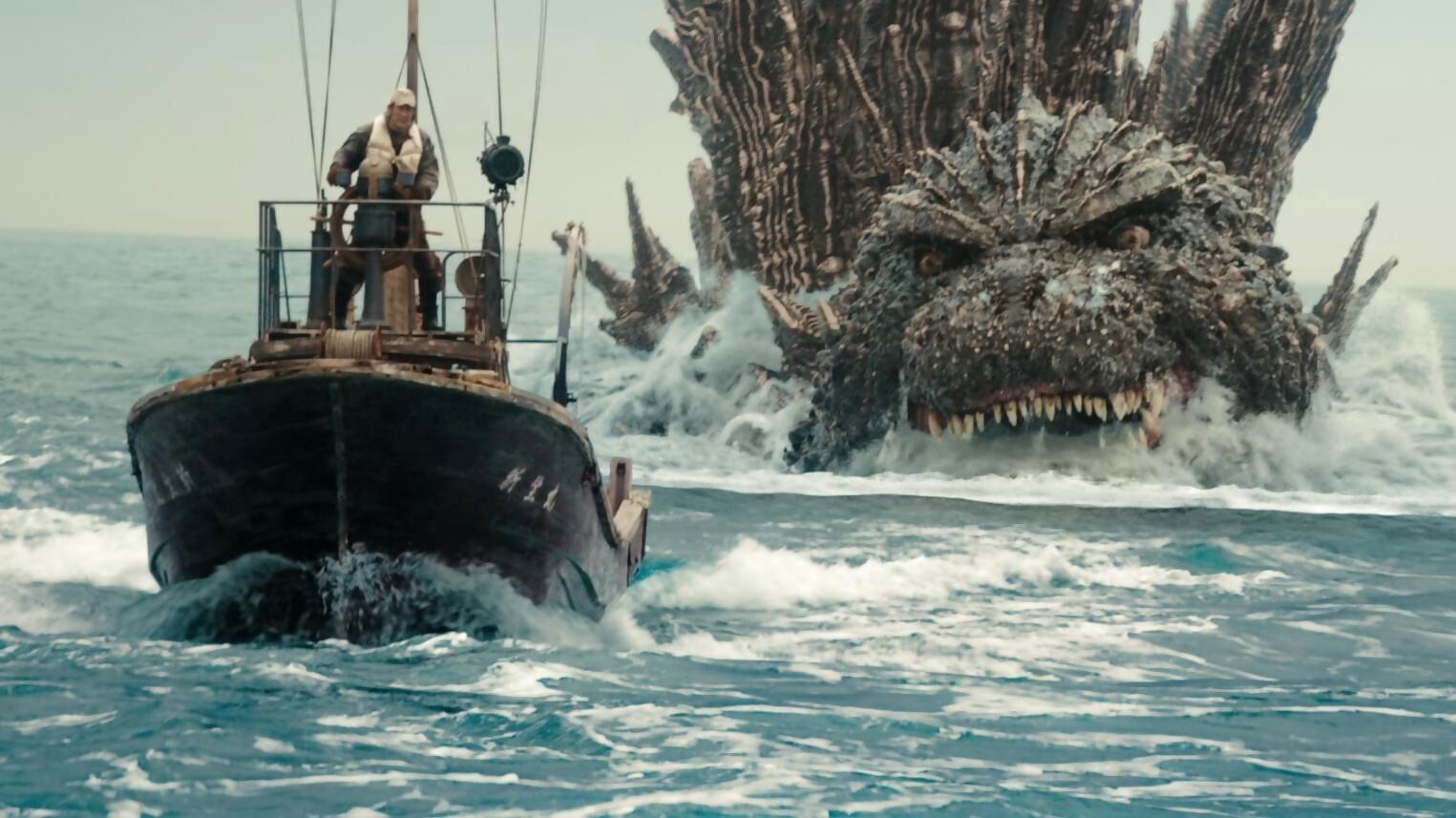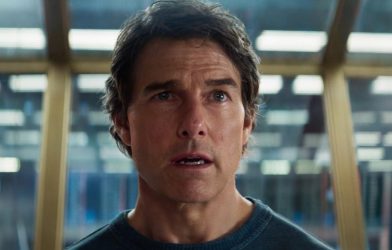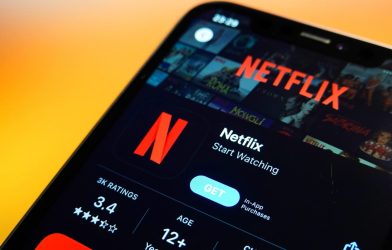Filmmaker Takahashi Yamazaki’s Godzilla Minus One may have won an Oscar for its VFX, but it’s the storytelling that Hollywood needs to learn from, Ryan writes.
You can tell that Godzilla Minus One is the work of a brilliant storyteller right from its opening scene. It’s World War II, and a lone Mitsubishi fighter plane flies over choppy waters towards an airfield on a lush, remote Japanese island. We then get a tighter shot of the aircraft as it touches down on a rutted landing strip: wheels kicking up dust, the bomb stowed beneath the plane hangs perilously close to the ground.
The viewer may not even consciously notice it, but this shot speaks volumes about kamikaze pilot Kōichi (Ryunosuke Kamiki), who we see for the first time in the next shot. First, that he’s landed without dumping his payload on the enemy; and second, even though he’ll soon be accused of cowardice, just flying and landing one of these planes takes an astonishing act of bravery and skill. Hitting a pothole or a rock on that stretch of runway – more suited to old wagons than cutting-edge military hardware – could easily set off that dangling bomb.
From here, filmmaker Takahashi Yamazaki does something that sounds simple in theory, but in practice is beyond the scope of most directors: each subsequent scene cleanly and economically tells the story of a protagonist overcoming his own trauma and survivor’s guilt. In turn, Kōichi’s story becomes that of an entire nation struggling to come to terms with its country’s near-destruction during the Second World War. Godzilla Minus One isn’t a short film at roughly 120 minutes, but barely a scene or shot is wasted. Every single one explores and expands on the themes established in its quiet opening.
It’s slightly ironic, really, that Yamazaki’s major coup earlier this year was his Oscar win for Best Visual Effects. Not because Godzilla Minus One doesn’t contain some excellent effects – they’re superb, particularly for a production of its budget – but because the VFX only play a small part in what makes the film an instant classic.
Like director Ishiro Honda’s Godzilla, released in 1954, Godzilla Minus One is a war film and a drama disguised as a monster movie. The fearsome creature may take the title role, but it’s a catalyst and a metaphor rather than a villain – Yamazaki recently referred to Godzilla as a “raging spirit” in an interview with The Verge.
There have been some very good and even terrific Godzilla movies released over the past 55 years, including Gareth Edwards’ 2014 Hollywood film and Toho’s wryly effective Shin Godzilla from 2016. For a Godzilla film as flat-out emotional as Godzilla Minus One, though, it’s arguable you have to go all the way back to Honda’s original.
Godzilla, released less than a decade after the nuclear devastation of Hiroshima and Nagasaki, felt like a collective cry of anguish from a country haunted by its recent history. Amid the film’s scenes of destruction, its most disturbing images are those of the aftermath – the dead and dying lined up in makeshift hospitals, and school children singing a song of peace.
In Minus One, which revives the first film’s wonderfully angst-filled score, the despair is similarly palpable. There’s a sense that, even without the nuclear bombings, the Japanese psyche was already broken. Tokyo had been firebombed, causing terrible loss of life (events also dramatised to powerful events in Studio Ghibli’s Grave Of The Fireflies and The Boy And The Heron). A generation of young pilots had been browbeaten by their superiors into flying suicide missions.

Read more: Godzilla Minus One review | The Godzilla film we’ve been dreaming of
Among the themes in Godzilla Minus One is the value of human life; the generation of ex-soldiers and survivors depicted by Yamazaki are roundly traumatised by how expendably they’ve been treated by their government. One character comments on how Japanese fighter planes were never fitted with ejector seats; another grimly jokes that a potentially fatal attempt to halt Godzilla’s campaign of destruction is still less futile than fighting in the War.
By the time Yamazaki’s spiky, ferocious incarnation of Godzilla has advanced on Tokyo, we’ve already gotten to know Kōichi and his makeshift family, Noriko (Minami Hamabe) and their surrogate daughter, Akiko. When Godzilla unleashes its deadly radioactive death ray – an act intentionally designed to look like an atomic bomb going off – it therefore provokes genuine horror rather than awe at some cleverly executed visual effects.
Incredibly, Yamazaki managed to make Godzilla Minus One for less than $10m – a fraction of this year’s Hollywood monster movie Godzilla X Kong: The New Empire, which cost somewhere around $135m or perhaps more. Yamazaki managed to keep his budget down by supervising the visual effects himself; its 610 VFX shots were handled by a small team of 35 artists.
More pivotally, Yamazaki kept costs down by ensuring he had a worthwhile, emotional story to tell before he started filming or devising effects sequences. Too often, expensive genre films are led by commerce or the mistaken assumption that spectacle by itself is enough. It’s why so many major films, whether they feature giant monsters or not, feel so hollow, and are often so bloated and expensive to make. Jurassic World: Dominion, for example, cost about $265m and proved to be so long that about 14 minutes had to be trimmed out to get the theatrical version under two and a half hours.

In short, Hollywood filmmakers shouldn’t just look at Godzilla Minus One as a case study in making effects-heavy movies on a low budget. They should look at how it tells an effective story first, and then uses VFX to help reinforce that story.
Lean, well acted and intelligently made, Godzilla Minus One was already considered an unexpectedly huge success on its cinema run, where it became the highest-grossing film in the series. Its fame has, if anything, only grown since; at the time of writing, it’s the number one film on both Netflix and ITunes. It’s all the more impressive given that Netflix barely advertised that the film was about to appear on the service.
Audiences, it seems, continue to be swept up by Yamazaki’s film. It may be set in a time and place unrecognisable to most of us, and it may nominally be about a giant monster stamping on things. But really, it’s about something far more immediate and universal – it’s about the human connections that drive us through life, and also about the lingering fears and anxieties that bear down on us.
Yamazaki, unsurprisingly, summed it up best. “I wanted Godzilla to feel like the physical embodiment of a kind of negative energy tied to people’s fears, worries, and disillusionment,” he told The Verge. “We – humans – we’re not necessarily there to kill Godzilla. We’re there to calm him. Minus One is about putting a name and face to something scary and inviting the audience to calm that negative presence through the shared experience of watching the film.”
—
Thank you for visiting! If you’d like to support our attempts to make a non-clickbaity movie website:
Follow Film Stories on Twitter here, and on Facebook here.
Buy our Film Stories and Film Junior print magazines here.
Become a Patron here.









